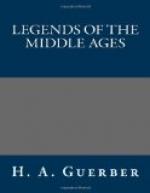Tristan, still unknown, remained at the Irish court for some time, spending many hours with Iseult, the daughter and namesake of the queen, whom he instructed daily in the art of music. After some months passed thus in pleasant intercourse, Tristan returned to Cornwall, where he related to Mark the story of his cure, and so extolled the beauty of young Iseult that the king finally expressed a desire to marry her. By the advice of the courtiers, who were jealous of Tristan, and who hoped that this mission would cost him his life, the young hero was sent to Ireland with an imposing retinue, to sue for the maiden’s hand and to escort her safely to Cornwall.
On landing in Dublin, Tristan immediately became aware that the people were laboring under an unusual excitement. Upon questioning them he learned that a terrible dragon had taken up its station near the city, that it was devastating the country, and that the king had promised the hand of Iseult to the man who would slay the monster. Tristan immediately concluded that by killing the dragon he would have the best chance of successfully carrying out his uncle’s wishes, so he sallied forth alone to attack it.
“This dragon had two
furious wings,
Each one upon
each shoulder;
With a sting in his tayl as
long as a flayl,
Which made him
bolder and bolder.
“He had long claws,
and in his jaws
Four and forty
teeth of iron;
With a hide as tough as any
buff
Which did him
round environ.”
Dragon
of Wantly (Old Ballad).
[Sidenote: Tristan and the dragon.] In spite of the fearful appearance of this dragon, and of the volumes of fire and venom which it belched forth, Tristan encountered it bravely, and finally slew it. Then, cutting out the monster’s tongue, he thrust it into his pocket, intending to produce it at the right moment. He had gone only a few steps, however, when, exhausted by his prolonged conflict, stunned by the poisonous fumes which he had inhaled, and overcome by the close contact with the dragon’s tongue, he sank fainting to the ground. A few moments later the butler of the Irish king rode up. He saw the dragon dead, with his conqueror lifeless beside him, and quickly resolved to take advantage of this fortunate chance to secure the hand of the fair princess. He therefore cut off the dragon’s head, and, going to court, boasted of having slain the monster just as it had killed a strange knight. Iseult and her mother, well aware that the man was a coward, refused to believe his story, and hastened off to the scene of the conflict, where they found the fainting Tristan with the dragon’s tongue in his pocket.
To remove the poisonous substance, (which they, however, preserved,) convey the knight to the palace, and restore him by tender care, was the next impulse of these brave women. Then, while Iseult the younger sat beside her patient, watching his slumbers, she idly drew his sword from the scabbard. Suddenly her eye was caught by a dint in the blade, which she soon discovered was of exactly the same shape and size as the fragment of steel which she had found in her uncle’s skull.




